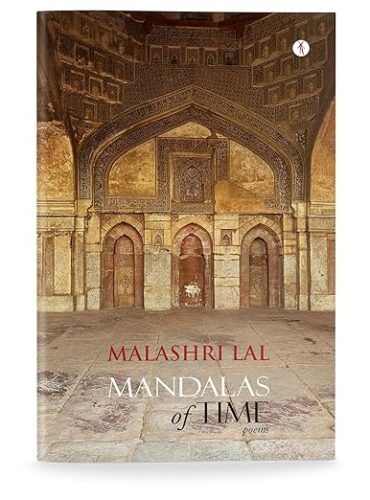Mandalas of Time , Malashri Lal, Hawakal Publishers Private Limited ; New Delhi, 2023, INR 500 (Hardback)ISBN: 978-81-960065-7-0
Mandalas of Time is a collection of seventy-five enchanting poems in different moods and perspectives. We are introduced to a collage of themes and subjects that fascinate, move and inspire us for a long time. There are poems which are a sensuous treat, redolent with colours, fragrances and music — the peacock’s feathers ‘blue, tinged in green,’ the first flush of dawn, carnation petals on the doorstep, abundant pansies, dahlias, mango blossoms and Easter lilies thriving in mellow fruitfulness.
The heat-defying Amaltas
Watches over troubled strangers —
Scarves wrapped around their head,
Umbrellas unfurled
Souls shrivelled more than the summer warrants. (‘Amaltas in Summer’)
“Life’s renewal is a beautiful certainty’ says former professor of English, Malashri Lal, who is a widely travelled soul maker. Far away from her home town, the pink city of Jaipur, her ancestral families were in Calcutta and Shantiniketan, some members of which assisted Rabindranath Tagore in the formative years of Visva-Bharati. The legacy stays in her beliefs:
I learnt from Gurudev
Emotions have no fixed language
The mind has no physical limits
Music resounds in the open sky
Dance is the joy of a free spirit anywhere.
A good poem is a movement in life; and a “good” poem will always try to reach the condition of music. Plainly speaking, it takes you from the level you are in to a higher plane, with melody and harmony:
This evening,
Goddess Lakshmi recalls
Those who are absent
By distance and time
Love and helplessness
Death and sickness. (‘Diwali with Goddess Lakshmi’)
Some poems are rooted in the world of being and feeling, conjuring up senses and sensibilities. Can Malashri’s eco-poetry drive climate action? In the age of mutual coexistence between human beings and nature, the earth anthem is very important. There is an awareness of today’s threat of climate change. Malashri is a serious activist, as for instance, in ‘Sita’s Pankha’, emphasizing the bond with the earth—
I sit at my meal,
The Pankha I give to my lord Rama
Gently he waves it over my thaali
Of banana leaf and forest fare,
Nature’s plenitude,
Our household, one with my Mother Earth.
Another enchanting poem is ‘Sita’s Rasoi’
Maternity calls
for justice,
no favourite child…
Food it is that holds us humans together.
Profound respect is offered to great personages such as Rabindranath Tagore, His Holiness the Dalai Lama, and Mahatma Gandhi, and educators like Maharani Gayatri Devi. The poet Gulzar’s love of library shelves filled with books catches the poet’s attention, reminding us of another time and place.
Characters from the great Indian epics occur often in this book, described subtly and poignantly. The myths stand out as cultural tropes for the celebration of selfhood and dignity. Myths rewrite the history of the land and its people. I like Malashri Lal’s precision in choosing images and connecting them with ancient legends. Some poems in this collection are rooted in the world of being and feeling, conjuring up sensibilities, values and ethical norms. These rich poems give us a sense of running, crossing river beds of Time and ultimately inhabiting a landscape of poetry:
My grandmother’s portrait
Merges with mine,
Today we’ve crossed a century
To share wrinkles of fatigue. (‘Family Portrait’)
Malashri Lal’s use of natural imagery is never exotic but it is poignant. She says,
More than skin and colour
I have inherited her joyful search
For infinity.
As an ardent, confident feminist, Malashri Lal introduces news stories about women who, as families of ‘migrant workers’, were leaving Delhi during the pandemic.
Leave the slum or pay the rent
Who cares if she is pregnant,
Get out — go anywhere. (‘Ladies Special’)
Malashri scans many cities. In her radiant faith Godhuli is vibrant in Delhi and ‘Howrah Bridge’ is a cantilever structure that comments on Calcutta.
Under the Howrah Bridge,
The boatman steers through muddy waters
Wondering at the undercarriage of cars and trams and trucks
That have crossed beyond his era.
Malashri Lal’s poems offer a kind of cleansing. Life’s fairy story can discover good in evil and light in the deepest darkness. This collection recreates the delicate fragrance of life, faithfully. We walk through it. This book is filled with symbols of silence, death, sickness, indifference, loneliness, loss, evening, night , but the poet ironically names the collection “Mandalas” for a contrasting effect between mutability and creative fancy. There are poems that are a sensuous delight, full of desire for life’s potential fulfillment; these are balanced by poems that accept pain and suffering. Nature remains a silent witness. To mention a few, the first flush of dawn, bougainvillea, red hibiscus, champa, mango blossoms and Easter lilies thriving in the garden of an old house. The title of the collection celebrates the unfaltering spirit of the poet. For Malashri Lal, hope gives the energy for rejuvenation. Her ‘Mandalas’ symbolize an incessant survival, living and longing that negates any dark despair.
Mandalas of Time is the unbound voice of a mapmaker in words. The souvenirs of sensations experienced with some mesmerizing poems can never die out. As we reach the last section, we are left yearning for more. Mandalas of Time will never be forgotten, as it will always reinforce youth and fearlessness.
*









Add comment